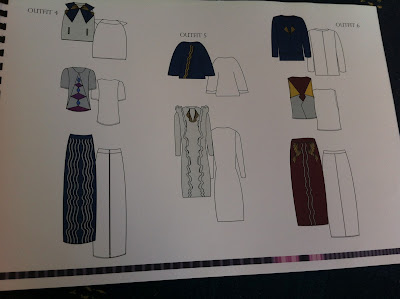Group Mood Board
The first page of my portfolio features the group mood board, which was required to be put into my portfolio.
Range Plan
The next page of my portfolio featured a double page showing the range plan for my chosen six outfits. The range plan features the front view in colour and the back view in white with black a outline and detail. The range also features the price of each garment, which i chose the prices for based on my shop report findings of Prada's price range of garments i reasearched.
Illustrations
The next part of my portfolio were these three pages of illustrations with featuring flat drawing back views, colour swatches in percentages, fabric swatches and the branding at the bottom of the page. The illustrations illustrate the three outfits i had chosen, with flat drawings that show the front/back that can't be seen that much on the illustrations.
These illlustrations turned out ok in the end eventhough im not confident at drawing illustrations. To help me i used magazine poses, and then adpated my three chosen outfits onto the figure. I experimented with fine liner, inks and water colours to create different rendering techniques to make my illustrations visual exciting to help me develop me own personal style.
Design Development
For the portfolio i scanned in and rearranged my design development by improving it on Photoshop. I professionally improved it by typing up my annotation and fabric samples. I scanned in and arranged fabric samples and swatches. I also changed the colour of some of my drawings to improve the visual quality of it to a high standard. I found that by rearranging my design development on Photoshop enabled me to improve the visual quality to a high standard, successfully creating, interesting and improved pages suitable for my professional portfolio.
These five photos above are of the five strongest design development pages i had chosen to include in my portfolio. To professionally present it i scanned in and rearranged my design development from landscape to portrait so it would match with the rest of my portfolio pages that were portrait as well.
I am pleased with my small portfolio i brought together as it shows my strengths at being able to produce and create a range on illustrator. The portfolio also shows my strong variations in design development that I’ve adapted further through designing. By creating a professional portfolio has helped me understand how to set out a portfolio for my third year work successfully by presenting it creatively.























































